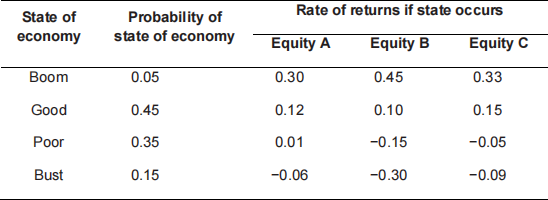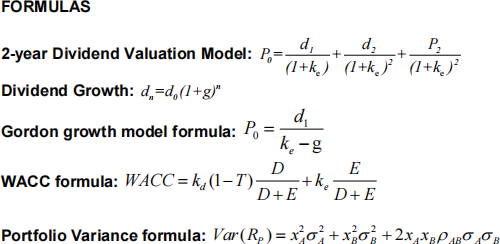ACCFIN5205 Corporate Finance
Hello, dear friend, you can consult us at any time if you have any questions, add WeChat: daixieit
Subject of Accounting and Finance
Degree of MSc (Management, Economics)
Degree Exam
Corporate Finance, ACCFIN5205
Question 1
1.1 Describe the forces pulling the management of a firm towards a dividend decision and critically discuss which one can prove the most powerful in practice.
(20%)
1.2 John proposes to invest in two shares, X and Y. He expects a return of 12% from X and 8% from Y. The standard deviation of returns is 8% for X and 5% for Y. The correlation coefficient between the returns is 0.2. You are given the following portfolios allocations.
|
Portfolio |
Invest % in X |
Invest % in Y |
|
1 |
50 |
50 |
|
2 |
25 |
75 |
|
3 |
75 |
25 |
Required:
• Compute the expected return and standard deviation for the above three allocations and sketch the possible Efficient Portfolio Frontier (EPF) for John’s investment.
• Explain what John’s optimal choice of investment would be if it assumed that he can borrow or lend at an interest rate of 5%.
(15%)
1.4 You estimate that by the time you retire in 35 years, you will have accumulated savings of $2 million. Your aim is to work out two spending plans of your savings for the next
15 years, one accounting for inflation and one without accounting for inflation. The interest rate is 8% and the inflation rate is expected to remain at the levels of 4% for the next decades.
Required: Calculate the annual level of expenditure your savings will support with and without accounting for inflation.
(15%)
TOTAL 50%
Question 2
2.1 Define the term Efficient Portfolio Frontier (EPF) and critically discuss its implications for investment decisions.
(20%)
2.2 Machines A and B are mutually exclusive and are expected to produce the following real cash flows:
|
Cash flow ($ thousands) |
||||
|
Machine |
|
|
|
|
|
A |
- 100 |
110 |
121 |
- |
|
B |
- 120 |
110 |
121 |
133 |
Required: Assuming the real opportunity cost of capital is 10%, calculate the Net Present Value (NPV) and the equivalent annual cash flow from each machine and make a recommendation regarding which machine should be bought.
(15%)
2.3 During the boom years of 2010-2014, a fund manager produced the following percentage rates of return. The S&P 500 market returns are provided for comparison.
|
Returns per year (%) |
|||||
|
Years |
2010 |
2011 |
2012 |
2013 |
2014 |
|
Manager |
24.9 |
-0.9 |
18.6 |
42.1 |
15.2 |
|
S&P 500 |
17.2 |
1.0 |
16.1 |
33.1 |
12.7 |
Required: Calculate the average return and standard deviation of the manager’s fund and explain whether the manager is beating the market by the measures available.
(15%) TOTAL 50%
![]() Question 3
Question 3
3.1 Explain the cash trade-off puzzle firms face and critically discuss the motives behind the firm cash holdings.
(20%)
3.2 Omega Corporation has 10 million shares outstanding trading now at $55 per share. The firm has estimated the expected rate of return to shareholders at 12%. It has also issued long-term bonds at an interest rate of 7% and has a debt value of $200 million. The corporate tax is 21%.
Required: Calculate Omega’s after-tax Weighted Cost of Capital (WACC) and explain how much higher WACC would be if Omega used no debt at all.
(15%)
3.3 Consider the following information regarding the state of the economy and the relevant returns for different assets:

Required: If your portfolio is invested 30 per cent each in A and C, and 40 per cent in B, calculate the expected return and standard deviation of the portfolio?
(15%)
TOTAL 50%

2021-12-15